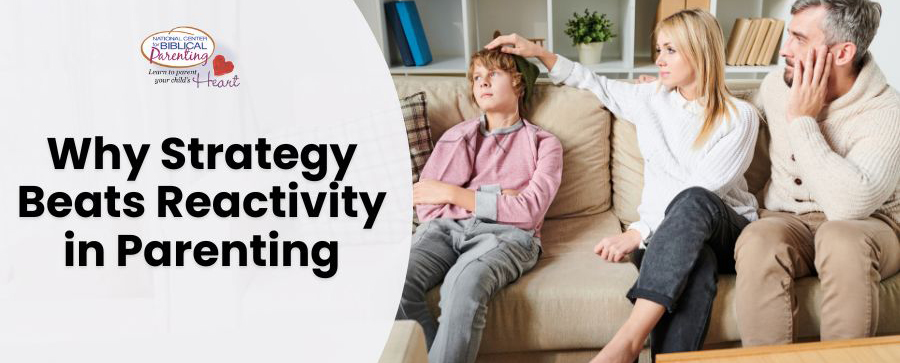Discipline in Public – The Best Strategy of All

The most-often-asked parenting question is, “What do I do when my kids act out in the grocery store?” It’s frustrating when children throw tantrums, run away, whine, complain, or disobey in the store. It would be nice to have a little booklet entitled, “How to Parent in Public,” that you could not only use for yourself but also pass on to others who need it.
The answer is that you don’t practice your discipline strategies in the grocery store. That’s the final exam! You practice in the kitchen, bedroom, laundry room, and backyard. Children need to learn how to handle disappointment at home so they can accept a no answer in the checkout line. Kids who haven’t learned how to accept correction at home without a bad attitude will miserably fail the test when they have an audience.
Training is the Key
Children develop patterns of relating. They’re predictable. You know that if you say no to your four-year-old, she’s likely to have a temper tantrum, or when you give an instruction to your eight-year-old she’ll argue with you, or when you correct your thirteen-year-old, he blames the problem on others, including you.
At times parents feel like they’re caught in a dance and they don’t know how to turn off the music. They know that things shouldn’t happen this way but it’s hard to make changes. These patterns are called relational routines and they become more ingrained over time.
Negative relational routines are most embarrassing when you’re in public. While at the grocery store, your son begins to argue just like he does at home. At church, your daughter reacts to you with the same disrespect you’ve been seeing for weeks. These public arenas aren’t the place to practice changing relational routines, at least not until you’ve done significant work at home.
Changing the Dance
The tendency for children to act in a particular way develops over time and often requires deliberate effort to change. Once you identify the specific problem, then practice doing the right thing over and over again. For example, Tyler, age 4, ignores his mom when she gives him an instruction. She has to say the same thing several times, often with increasing intensity, before he responds.
Mom decides to work on her instruction routine with Tyler. Mom realizes that part of the problem in their pattern is that she gives Tyler instructions while he’s still involved in his playing. Mom decides to change the pattern and determines not to give instructions to her son until he’s broken concentration from his activity. In fact, Mom explains to Tyler that from now on she’s going to just call his name and expect him to come when called. Tyler won’t know why Mom is calling him. It may be because it’s time to go out the door, or time to have a snack, or just because she wants to say “I love you.”
Mom then begins the work by practicing this new “come when you’re called” rule with Tyler. Most of the time he comes but sometimes he doesn’t, resulting in immediate correction. Mom affirms Tyler for his responsiveness when he comes and once she has him close and gives an instruction, she sees marked improvement in his responsiveness. Mom continues to practice the new routine with Tyler several times a day. Then she practices at the park and around the neighborhood. When she feels confident that Tyler has changed the relating pattern significantly, Mom tries the new routine at the store or at church with encouraging results.
Disrespect is an Unhealthy Pattern
Ron realized that his teenage daughter was disrespectful to him in front of her friends. He’d seen the same sarcasm and unkindness when they were alone but it was particularly disturbing in front of others. Ron realized that although the “public” routine matched the “private” routine, the embarrassment was greater with an audience. Ron didn’t want to just look good in public, however, so he began to change the way he and his daughter related in private.
When Ron sensed that his daughter was being rude, sarcastic, or unkind in their discussions, he’d stop the dialogue with some kind of statement like “That wasn’t kind” or “You don’t have to treat me unkindly because you disagree.” In some situations the comment was enough for his daughter to snap back into more healthy dialogue. On a couple of occasions, though, his daughter was particularly angry and refused to back down. Dad required a break from the dialogue to settle down and even told his daughter that she needed to stay off the computer and even out of her bedroom until she was willing to talk to him about the problem in a mature way.
After working on the relating pattern for a few weeks, Ron found himself in the same situation receiving disrespect in front of his daughter’s friends, but this time he was ready. Ron called his daughter out of the group into the other room and confronted her. She received the correction in part because of the work that he’d done the preceding weeks and she knew that he was serious about the change.
Practice, Practice, Practice
Patterns take time to adjust and often require that parents focus on relational routines. The next time you’re frustrated with the interaction you see with your child, stop and consider whether it’s a pattern. If so, try to figure out what the triggers are that get it started. Next, identify some new ways of relating and then practice them over and over again until they become the new habit.
The English word “instruction” comes from the words “in” and “structure” and basically means “to put structure into.” When someone comes on the scene and gives instructions, that person brings structure to the situation and helps people know what to do. When Mom sees the negative relating pattern and gives guidelines on how to interact in a more positive way, she adds the structure needed at the moment to make family life work. Unfortunately, because of the well-worn relationship between parent and child, kids may react with resistance. That’s because the habits are built over time and need concentrated effort to change.
Hang in there. Remember that you’re not giving instructions about how to relate simply to make life easier. You’re helping children develop strong relating patterns for the future. Without clear guidelines about structure in relational routines, family life falls apart. Instruction doesn’t just mean telling kids what to do though. It means practicing the right way to relate over and over again.
So, what is the best strategy for disciplining in public? Practice at home. Identify patterns, practice right responses and then test those responses at the neighbors, at the park, and then at the store.
Ephesians 6:1 says, “Children, obey your parents in the Lord, for this is right.” Parents don’t require obedience because it’s convenient. It’s the right thing to do. Practicing the right thing over and over again helps children develop patterns that will help them forever. See Dr Turansky’s Facebook live video here:












Leave a Reply
Want to join the discussion?Feel free to contribute!